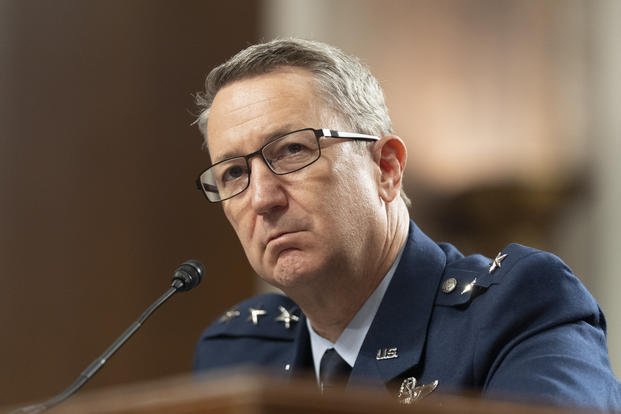
A narrow stretch of federal lands that runs along a major portion of the U.S.-Mexico border has been transferred to the military in hopes of increasing migrant apprehensions under a new memo signed by President Donald Trump.
The Roosevelt Reservation, the 60-foot-wide strip of land that stretches across California, Arizona and New Mexico, will be treated as Department of Defense property, meaning those who walk on the land could be subject to detention and likely legal action.
Trump's memo released publicly Friday stated the effort "will initially implement this memorandum on a limited sector of federal lands designated by the secretary of defense." A defense official told Military.com that the Department of the Interior will soon pass over jurisdiction of the land but had not as of Monday afternoon, adding that military apprehension efforts on the Roosevelt Reservation will initially take place near Fort Huachuca[1], Arizona.
Read Next: Beneficiaries Outside Drive Time Standard No Longer Need Waiver to Stay in Tricare Prime[2]
Trump's ordered transfer of the federal land to the Department of Defense marks a new and unprecedented frontier in modern U.S. history[3] for the use of the military in his crackdown on immigrants and efforts to seal America's southern border with Mexico. Military.com spoke with legal experts who expressed concern about the Roosevelt Reservation's militarization, and also recently visited the southern border of California to witness troops' operations firsthand just prior to the memo's release.
The military is not legally allowed to take on law enforcement activities except in certain rare cases, and putting troops in charge of migrant apprehensions now conducted by police or immigration and border agents pushes the boundaries of the law, according to legal experts.
Prior to Trump's memo last week, soldiers had already begun conducting patrols along the barrier wall separating the U.S. and Mexico in an effort to detect and track suspected illegal activity. A U.S. Northern Command order in late March gave troops the ability to patrol border routes, something that the command said would give them more "maneuverability" in support of their Customs and Border Protection counterparts.
Those patrols included dedicated military assets, such as the Stryker[4], an armored vehicle largely meant to transport troops to and from missions. The inclusion of that equipment marks a significant shift from active-duty border missions of the past, in which service members were often limited to Border Patrol vehicles or optics without the ability to move from stationary observation posts along the border.
The Roosevelt Reservation was first established in the early 1900s by then-President Theodore Roosevelt to stop smuggling efforts into the country. Elizabeth Goitein, senior director of the nonprofit Brennan Center's Liberty and National Security Program, told Military.com in an interview that the latest memo takes the original purpose of the land and puts it into unchartered territory.
"It's a quantum leap, because the original designation of the land did not come along with militarizing the zone and sort of bootstrapping a way for soldiers to arrest migrants or to enforce drug trafficking laws at the border," Goitein said.
The move appears aimed at navigating around Posse Comitatus -- a federal act stopping the U.S. military from performing certain law enforcement duties -- and Goitein questioned the legality of the move as a whole.
"This is not incidental; this is not because something unexpected happened," she said. "They are setting out to arrest and detain migrants by building this installation, and that is not consistent with Posse Comitatus. It just isn't."
Detention Facility Under Construction
A Military.com in-depth feature[5] last month detailed that the plan for the Roosevelt Reservation was awaiting Trump's signature before being put into action.
The report also said that Defense Secretary Pete Hegseth authorized the Army[6] to assume control and management of Customs and Border Protection and Immigration and Customs Enforcement contracts for construction, maintenance and upkeep of the existing processing center at Fort Bliss[7] in El Paso, Texas -- a sprawling military installation along the U.S.-Mexico border.
Now, construction is underway for the Fort Bliss detention facility.
The Army last week began prepping the site at Fort Bliss for the construction of the new migrant detention facility expected to hold as many as 5,000 people, according to two Army officials briefed on the matter. The officials spoke on the condition of anonymity because they were not authorized to discuss the plans publicly. That preparation has included 1st Armored Division soldiers clearing rocks and flattening dirt with bulldozers.
Details about the composition of the detainee population remain unclear, including whether the facility will hold both individuals deemed security risks and migrant families. Bliss was used to house thousands of Afghans during a major Biden administration resettlement effort after U.S. troops pulled out of the two-decade war in 2021.
Goitein said that providing that detention space is not unprecedented, but how officials may use the military in future operations at the detention facility is where legal concerns may begin to appear.
"This is part of an overall blurring of the line between military and law enforcement in the immigration space that we're seeing throughout the Trump administration's actions, and that line has to remain very clear under the Posse Comitatus Act," Goitein said. "This kind of blurring of that line is not legal, and it's dangerous."
The Trump administration has already blurred the lines of legality in its nationwide deportations. On Monday, Trump and visiting El Salvador President Nayib Bukele met at the White House and said they would not return Kilmar Abrego Garcia[8], a Maryland father and legal resident who was mistakenly deported to a notorious Salvadoran prison by the administration, back to the U.S. despite an order by the Supreme Court.
Although the new detention facility is being built on Fort Bliss, officials emphasized that uniformed service members will not oversee daily operations. Instead, the site will be jointly managed by Immigration and Customs Enforcement. Pro Publica reported[9] the contract to build the camp has been awarded to Deployed Resources, a private company specializing in massive long-term-use tents.
The company is known for erecting large-scale, tent-based infrastructure, which officials say allows for faster deployment compared to traditional infrastructure -- though it's unclear whether those structures could adequately house a large number of people and address sanitation and health needs.
Changing Border Mission
The Pentagon has deployed a force of roughly 10,000 troops to the border in an effort to secure it. That is only part -- albeit a significant part -- of the military's role in the immigration mission, which also has included deportation flights, migrant detention at Guantanamo Bay and now construction of facilities on U.S. soil, efforts that have come together rapidly in less than 90 days.
Military.com recently spent time with soldiers belonging to a task force mostly made up of military police deployed near San Diego at California's border, where some service members described their foot patrols along the barrier wall prior to the president's most recent memo. They were not using Strykers.
"When we first got here, we were pretty much static along the border," said Lt. Col. Phillip Mason, the commander of Task Force-716, a unit composed mostly of military police. "Since then, we have been able to do patrolling. We've been able to -- instead of just sitting behind a camera -- we can move back and forth along the border," adding that it allows his soldiers "a better ability to understand what's going on."
Sgt. DeAndre Swinson, an acting squad leader assigned to the border and sergeant of the guard for soldiers manning observation posts, said that he had been on two patrols since Northern Command authorized units to do so, taking groups of about four armed soldiers at a time along the border barrier to report to CBP agents anything suspicious they might see.
"If it's on the patrol, we report immediately through [our] radio, and you'll tell them exactly how you see it, what you see," he said. When asked what he is looking for on the patrols, Swinson said "anything that looks out of the ordinary," adding that reports to nearby Border Patrol agents include the "five Ws" -- who, what, when, where and why.
Specifically, they are looking for border crossings and "spotters," a term commonly referring to individuals -- to include suspected cartel or smuggling groups -- monitoring law enforcement or military activity along the border in order to circumvent detection in an effort to cross people, drugs or contraband into the U.S.
On these patrols, soldiers are required to abide by the standing rules for the use of force, also known as SRUF, which dictates what kinds of force they can and can't use if faced with a threatening situation.
For Task Force-716, those rules did not change when they started doing the patrols, Mason said, adding that as of last Thursday, his troops had not had any direct contact with migrants crossing the border in the nearly three months they'd been in San Diego.
"There's times where it's seen from anywhere from 500 meters to a mile away," he said Thursday. "But not eye-to-eye, face-to-face kind of contact, and a lot of that is by design. Our soldiers aren't in a capacity where they should be detaining, apprehending." He added that they are allowed to provide medical treatment to migrants should they hurt themselves attempting to traverse the barrier wall, for example.
But operations along the border are now evolving rapidly as Trump and his administration move forward with plans to expand the military's role in immigration enforcement.
By the time Military.com's coverage of the troops at San Diego ended Friday afternoon, the president had issued the memorandum authorizing the use of the Roosevelt Reservation.
That order could now indeed put troops face-to-face with migrants in a way that has not happened in recent border missions -- and what that will mean or look like for those troops is still unclear.
-- Konstantin Toropin contributed to this report.
Related: Navy Plans to Deploy Second Destroyer to Patrol Waters Off US and Mexico This Week[10]
© Copyright 2025 Military.com. All rights reserved. This article may not be republished, rebroadcast, rewritten or otherwise distributed without written permission. To reprint or license this article or any content from Military.com, please submit your request here[11].
